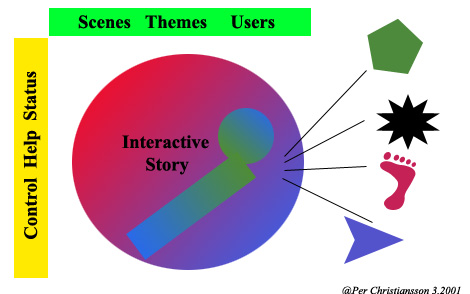INTERACTIVE STORY TELLING
Content
PossibilitiesStory Telling Cases
Define the users
Lead the user
Data collection
Available tools
Premice again

Interactive stories can be told in many forms using the same underlying data.
Possibilities
Computer stored presentations and multimedia gives us opportunities to- produce non-linear presentations with provision to easy jumps in storytime line, provide easy access to explanations and deeper insights, immediate and easy feed-back from user,
- easy access to alternative stories to investigate a subject and stored material/data.
- possibilities to easily create alternative scenes (rooms, maps, etc.) and themes (discover, learn, get informed, etc.) using the same base material/data.
There are of course also a risk that the user will read the story in a fashion we did not expect, leaving important parts out. This can be avoided with different control mechanims (you can only continue after having 'read' this, mark what you have read and come back later).
Design your presentation starting with conceptual sketches. Involve the client early in the specifications and design work.
Story Telling Cases
Interactive or linear story telling can be used in many contexts.. For example
- External company presentation
Owners, culture, long-term strategies, strong sides, products, service and support, growth, plans, R&D, reference cases, customer feed-back, qualities/prices, .... - Internal company presentation (prepare for change, stimulate feed-back,...)
- News
- Missioning
- Product presentation and use
- Building community and shared values
- Consumer to business relations
- Business to business relations
A story consists of three parts
- Beginning
- Middle (a journey from one 'place' to another)
- End
Define the users
Define the users of the presentation with regard to- Competence in the knowledge domains under consideration
- Experiences of non-linear presentations
- Interest in the knowledge domain
- Degree of active control in the interactive presentation
- Expected learning outcome
Lead the user
The interactive stories may be more or less self explaining dependent on the type of story we are telling- Communication support within the company,
- Enforcing shared values within company,
- Company product presentation,
- etc.
There are different ways to lead the user through the presentation
- tree structure more or less explicitly shown (graphic tree, menus, position feed-back by clicking in scenes,...)
- different scenarios to navigate in (predefined routes, alternative choices and actions on the way)
- interactive simulation of a real course of events (installation, trading, using a tool,....)
Data collection
The material/data we can use in our presentations may be- videos and video clips
- images and interactive images
- sound (music, talking, environmental sounds)
- interactive 3D models
- clickable image maps
- text
- interactive graphics
- etc.
What sources of data do you have access to
- images
- videos
- text documents
- graphics
- drawings
- 3D models
- existing presentations
- etc.
Plan the data collection with regard to possible usage in different 'stories'. Decide on suitable forms of data representations (images, video, text, sound, graphics, models, ....)
Structure and store the data so it can be easily used in different multimedia presentations.
Available tools
Decide on which ICT tools you plan to use and have access to- authoring tools
- graphic editing
- video editing
- 3D model presentations
- data collection tools
- etc.
Premise again
From the video story telling lecture we allude:It may be helpful to condense the aim with the interactive story to one sentence ('premice'). Use this during the whole production and throw away parts that does not contribute to confirm the sentence.
Further reading
- ....